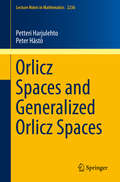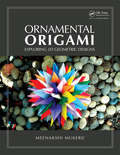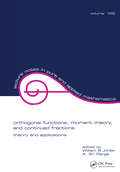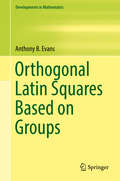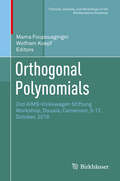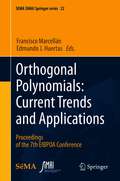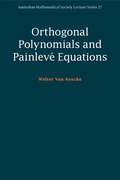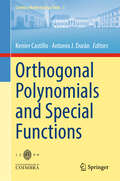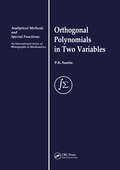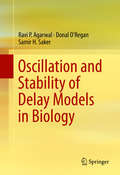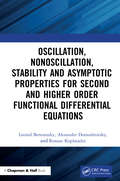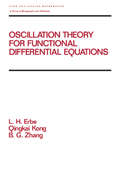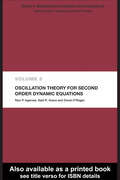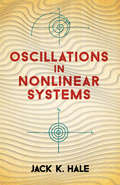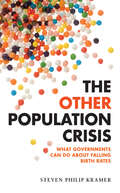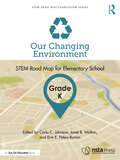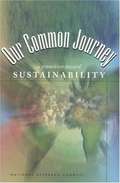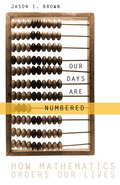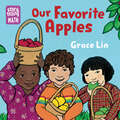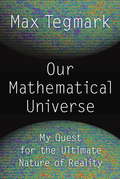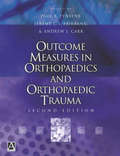- Table View
- List View
ORIGO Stepping Stones, Programa de matemáticas [Grade 5], Libro del alumno: Spanish Edition
by James Burnett Calvin Irons Debi DePaulNIMAC-sourced textbook
ORIGO Stepping Stones, Programa de matemáticas [Grade K], Libro del alumno: Spanish Edition
by Rosemary Irons James Burnett Peter StowasserNIMAC-sourced textbook
Orlicz Spaces and Generalized Orlicz Spaces (Lecture Notes in Mathematics #2236)
by Petteri Harjulehto Peter HästöThis book presents a systematic treatment of generalized Orlicz spaces (also known as Musielak–Orlicz spaces) with minimal assumptions on the generating Φ-function. It introduces and develops a technique centered on the use of equivalent Φ-functions. Results from classical functional analysis are presented in detail and new material is included on harmonic analysis. Extrapolation is used to prove, for example, the boundedness of Calderón–Zygmund operators. Finally, central results are provided for Sobolev spaces, including Poincaré and Sobolev–Poincaré inequalities in norm and modular forms. Primarily aimed at researchers and PhD students interested in Orlicz spaces or generalized Orlicz spaces, this book can be used as a basis for advanced graduate courses in analysis.
Ornamental Origami: Exploring 3D Geometric Designs (Ak Peters Ser.)
by Meenakshi MukerjiThis book is a great resource for people who enjoy polyhedra, symmetry, geometry, mathematics and origami. The types of models presented are similar in nature to the models in Mukerji's Marvelous Modular Origami, but some of the chapters are more advanced and all of the designs are new. The reader can learn about polyhedra while making these models and is left with the ability to design one's own models. Step-by-step folding instructions for over 40 models are presented. Although the book is for intermediate folders, beginners are encouraged to try because origami basics are explained. The diagrams are easy to follow and each model is accompanied by breathtaking finished model photographs.
Orthogonal Functions: Moment Theory and Continued Fractions
by William B. Jones; A. Sri Ranga"Oulines an array of recent work on the analytic theory and potential applications of continued fractions, linear functionals, orthogonal functions, moment theory, and integral transforms. Describes links between continued fractions. Pade approximation, special functions, and Gaussian quadrature."
Orthogonal Latin Squares Based on Groups (Developments in Mathematics #57)
by Anthony B. EvansThis monograph presents a unified exposition of latin squares and mutually orthogonal sets of latin squares based on groups. Its focus is on orthomorphisms and complete mappings of finite groups, while also offering a complete proof of the Hall–Paige conjecture. The use of latin squares in constructions of nets, affine planes, projective planes, and transversal designs also motivates this inquiry. The text begins by introducing fundamental concepts, like the tests for determining whether a latin square is based on a group, as well as orthomorphisms and complete mappings. From there, it describes the existence problem for complete mappings of groups, building up to the proof of the Hall–Paige conjecture. The third part presents a comprehensive study of orthomorphism graphs of groups, while the last part provides a discussion of Cartesian projective planes, related combinatorial structures, and a list of open problems. Expanding the author’s 1992 monograph, Orthomorphism Graphs of Groups, this book is an essential reference tool for mathematics researchers or graduate students tackling latin square problems in combinatorics. Its presentation draws on a basic understanding of finite group theory, finite field theory, linear algebra, and elementary number theory—more advanced theories are introduced in the text as needed.
Orthogonal Polynomials: 2nd AIMS-Volkswagen Stiftung Workshop, Douala, Cameroon, 5-12 October, 2018 (Tutorials, Schools, and Workshops in the Mathematical Sciences)
by Wolfram Koepf Mama FoupouagnigniThis book presents contributions of international and local experts from the African Institute for Mathematical Sciences (AIMS-Cameroon) and also from other local universities in the domain of orthogonal polynomials and applications. The topics addressed range from univariate to multivariate orthogonal polynomials, from multiple orthogonal polynomials and random matrices to orthogonal polynomials and Painlevé equations.The contributions are based on lectures given at the AIMS-Volkswagen Stiftung Workshop on Introduction of Orthogonal Polynomials and Applications held on October 5–12, 2018 in Douala, Cameroon. This workshop, funded within the framework of the Volkswagen Foundation Initiative "Symposia and Summer Schools", was aimed globally at promoting capacity building in terms of research and training in orthogonal polynomials and applications, discussions and development of new ideas as well as development and enhancement of networking including south-south cooperation.
Orthogonal Polynomials: Proceedings of the 7th EIBPOA Conference (SEMA SIMAI Springer Series #22)
by Francisco Marcellán Edmundo J. HuertasThe present volume contains the Proceedings of the Seventh Iberoamerican Workshop in Orthogonal Polynomials and Applications (EIBPOA, which stands for Encuentros Iberoamericanos de Polinomios Ortogonales y Aplicaciones, in Spanish), held at the Universidad Carlos III de Madrid, Leganés, Spain, from July 3 to July 6, 2018.These meetings were mainly focused to encourage research in the fields of approximation theory, special functions, orthogonal polynomials and their applications among graduate students as well as young researchers from Latin America, Spain and Portugal. The presentation of the state of the art as well as some recent trends constitute the aim of the lectures delivered in the EIBPOA by worldwide recognized researchers in the above fields.In this volume, several topics on the theory of polynomials orthogonal with respect to different inner products are analyzed, both from an introductory point of view for a wide spectrum of readers without an expertise in the area, as well as the emphasis on their applications in topics as integrable systems, random matrices, numerical methods in differential and partial differential equations, coding theory, and signal theory, among others.
Orthogonal Polynomials and Painlevé Equations
by Walter Van AsscheThere are a number of intriguing connections between Painlevé equations and orthogonal polynomials, and this book is one of the first to provide an introduction to these. Researchers in integrable systems and non-linear equations will find the many explicit examples where Painlevé equations appear in mathematical analysis very useful. Those interested in the asymptotic behavior of orthogonal polynomials will also find the description of Painlevé transcendants and their use for local analysis near certain critical points helpful to their work. Rational solutions and special function solutions of Painlevé equations are worked out in detail, with a survey of recent results and an outline of their close relationship with orthogonal polynomials. Exercises throughout the book help the reader to get to grips with the material. The author is a leading authority on orthogonal polynomials, giving this work a unique perspective on Painlevé equations.
Orthogonal Polynomials and Special Functions (Coimbra Mathematical Texts #3)
by Kenier Castillo Antonio J. DuránThe aim of this book is to honor the memory of Professor José Carlos Petronilho and hence focuses on his main research areas (Special Functions, Orthogonal Polynomials, Approximation Theory). It is a collaborative book and among the contributing authors are outstanding leaders in the field. The book addresses different topics exploring the connection between the areas already mentioned and their applications, from different perspectives and using several tools, both analytical and algebraic. Beside the researches working in these topics, the book potentially interests the readers working in areas of Mathematics, Science and Technology where Approximation Theory, Special Functions and Orthogonality are potentially useful tools.
Orthogonal Polynomials in Two Variables (Analytical Methods And Special Functions Ser.)
by P.K. SuetinPresenting a comprehensive theory of orthogonal polynomials in two real variables and properties of Fourier series in these polynomials, this volume also gives cases of orthogonality over a region and on a contour. The text includes the classification of differential equations which admits orthogonal polynomials as eigenfunctions and several two-dimensional analogies of classical orthogonal polynomials.
Orthogonal Polynomials of Several Variables
by Charles F. Dunkl Yuan XuThis is the first modern book on orthogonal polynomials of several variables, which are valuable tools used in multivariate analysis, including approximations and numerical integration. The book presents the theory in elegant form and with modern concepts and notation. It introduces the general theory and emphasizes the classical types of orthogonal polynomials whose weight functions are supported on standard domains such as the cube, the simplex, the sphere and the ball. It also focuses on those of Gaussian type, for which fairly explicit formulae exist. The authors' approach blends classical analysis and symmetry-group-theoretic methods. The book will be welcomed by research mathematicians and applied scientists, including applied mathematicians, physicists, chemists and engineers.
Oscillation and Stability of Delay Models in Biology
by Ravi P. Agarwal Donal O'Regan Samir H. SakerEnvironmental variation plays an important role in many biological and ecological dynamical systems. This monograph focuses on the study of oscillation and the stability of delay models occurring in biology. The book presents recent research results on the qualitative behavior of mathematical models under different physical and environmental conditions, covering dynamics including the distribution and consumption of food. Researchers in the fields of mathematical modeling, mathematical biology, and population dynamics will be particularly interested in this material.
Oscillation, Nonoscillation, Stability and Asymptotic Properties for Second and Higher Order Functional Differential Equations
by Leonid Berezansky Alexander Domoshnitsky Roman KoplatadzeAsymptotic properties of solutions such as stability/ instability,oscillation/ nonoscillation, existence of solutions with specific asymptotics, maximum principles present a classical part in the theory of higher order functional differential equations. The use of these equations in applications is one of the main reasons for the developments in this field. The control in the mechanical processes leads to mathematical models with second order delay differential equations. Stability and stabilization of second order delay equations are one of the main goals of this book. The book is based on the authors’ results in the last decade. Features: Stability, oscillatory and asymptotic properties of solutions are studied in correlation with each other. The first systematic description of stability methods based on the Bohl-Perron theorem. Simple and explicit exponential stability tests. In this book, various types of functional differential equations are considered: second and higher orders delay differential equations with measurable coefficients and delays, integro-differential equations, neutral equations, and operator equations. Oscillation/nonoscillation, existence of unbounded solutions, instability, special asymptotic behavior, positivity, exponential stability and stabilization of functional differential equations are studied. New methods for the study of exponential stability are proposed. Noted among them inlcude the W-transform (right regularization), a priory estimation of solutions, maximum principles, differential and integral inequalities, matrix inequality method, and reduction to a system of equations. The book can be used by applied mathematicians and as a basis for a course on stability of functional differential equations for graduate students.
Oscillation Theory for Functional Differential Equations (Chapman And Hall/crc Pure And Applied Mathematics Ser. #190)
by Lynn ErbeExamines developments in the oscillatory and nonoscillatory properties of solutions for functional differential equations, presenting basic oscillation theory as well as recent results. The book shows how to extend the techniques for boundary value problems of ordinary differential equations to those of functional differential equations.
Oscillation Theory for Second Order Dynamic Equations (Mathematical Analysis and Applications)
by Ravi P. Agarwal Said R. Grace Donal O'ReganThe qualitative theory of dynamic equations is a rapidly developing area of research. In the last 50 years, many scholars have studied the oscillation theory of ordinary, functional, neutral, partial, and impulsive differential equations. Many books deal with oscillation theory, but in a way that appeals only to researchers already familiar with the subject. In an effort to bring the topic to a new and broader audience, the authors clearly explain oscillation theory for second-order differential equations. They include several examples to illustrate the theory and to inspire new direction. This text is ideal for students and researchers in applied mathematics, engineering science, and numerical analysis.
Oscillations in Nonlinear Systems (Dover Books on Mathematics)
by Jack K. HaleBy focusing on ordinary differential equations that contain a small parameter, this concise graduate-level introduction to the theory of nonlinear oscillations provides a unified approach to obtaining periodic solutions to nonautonomous and autonomous differential equations. It also indicates key relationships with other related procedures and probes the consequences of the methods of averaging and integral manifolds.Part I of the text features introductory material, including discussions of matrices, linear systems of differential equations, and stability of solutions of nonlinear systems. Part II offers extensive treatment of periodic solutions, including the general theory for periodic solutions based on the work of Cesari-Halel-Gambill, with specific examples and applications of the theory. Part III covers various aspects of almost periodic solutions, including methods of averaging and the existence of integral manifolds. An indispensable resource for engineers and mathematicians with knowledge of elementary differential equations and matrices, this text is illuminated by numerous clear examples.
The Other Population Crisis: What Governments Can Do about Falling Birth Rates
by Steven Philip KramerIn many developed countries, population decline poses economic and social strains and may even threaten national security. Through historical-political case studies of Sweden, France, Italy, Japan, and Singapore, The Other Population Crisis explores the motivations, politics, programming, and consequences of national efforts to promote births. Steven Philip Kramer finds a significant government role in stopping declines in birth rates. Sweden’s and France’s pro-natalist programs, which have succeeded, share the characteristics of being universal, not means-tested, and based on gender equality and making it easy for women to balance work and family. The programs in Italy, Japan, and Singapore, which have failed so far, have not devoted sufficient resources consistently enough to make a difference and do not support gender equality and women’s work-family balance, Kramer finds.
Our Changing Environment, Grade K: STEM Road Map for Elementary School (STEM Road Map Curriculum Series)
by Carla C. Johnson Janet B. Walton Erin E. Peters-BurtonWhat if you could challenge your kindergartners to come up with a way to reduce human impact on the environment? With this volume in the STEM Road Map Curriculum Series, you can! Our Changing Environment outlines a journey that will steer your students toward authentic problem solving while grounding them in integrated STEM disciplines. Like the other volumes in the series, this book is designed to meet the growing need to infuse real-world learning into K–12 classrooms. This interdisciplinary, three-lesson module uses project- and problem-based learning to help students investigate the environment around them, with a focus on ways that humans can impact the environment. Working in teams, students will investigate various types of human impact on the environment (including pollution, littering, and habitat destruction), will participate in a classroom recycling program, and will explore the engineering design process as they devise ways to repurpose waste materials. To support this goal, students will do the following: Identify human impacts on the environment. Identify technological advances and tools that scientists use to learn about the changing environment, and use technology to gather data. Explain, discuss, and express concepts about the environment through development and design of a publication to report their scientific findings about the environment around the school. Chart and understand local weather patterns, and make connections between weather conditions and their observations of the environment. Identify and demonstrate recycling practices, including sorting materials and tracking amounts of materials recycled, and participate in a class recycling program. The STEM Road Map Curriculum Series is anchored in the Next Generation Science Standards, the Common Core State Standards, and the Framework for 21st Century Learning. In-depth and flexible, Our Changing Environment can be used as a whole unit or in part to meet the needs of districts, schools, and teachers who are charting a course toward an integrated STEM approach.
Our Common Journey: A Transition Toward Sustainability
by National Research CouncilWorld human population is expected to reach upwards of 9 billion by 2050 and then level off over the next half-century. How can the transition to a stabilizing population also be a transition to sustainability? How can science and technology help to ensure that human needs are met while the planet's environment is nurtured and restored?Our Common Journey examines these momentous questions to draw strategic connections between scientific research, technological development, and societies' efforts to achieve environmentally sustainable improvements in human well being. The book argues that societies should approach sustainable development not as a destination but as an ongoing, adaptive learning process. Speaking to the next two generations, it proposes a strategy for using scientific and technical knowledge to better inform future action in the areas of fertility reduction, urban systems, agricultural production, energy and materials use, ecosystem restoration and biodiversity conservation, and suggests an approach for building a new research agenda for sustainability science.Our Common Journey documents large-scale historical currents of social and environmental change and reviews methods for "what if" analysis of possible future development pathways and their implications for sustainability. The book also identifies the greatest threats to sustainability--in areas such as human settlements, agriculture, industry, and energy--and explores the most promising opportunities for circumventing or mitigating these threats. It goes on to discuss what indicators of change, from children's birth-weights to atmosphere chemistry, will be most useful in monitoring a transition to sustainability.
Our Days Are Numbered
by Jason BrownA revealing and entertaining look at the world, as viewed through mathematical eyeglasses.From the moment our feet touch the floor in the morning until our head hits the pillow, numbers are everywhere. And yet most of us go through each day unaware of the mathematics that shapes our lives.In fact, many people go through life fearing and avoiding mathematics, making choices that keep it at arm's length or further. Even basic math -- like arithmetic -- can seem baffling.In Our Days Are Numbered, Jason Brown leads the reader through a typical day, on a fascinating journey. He shows us the world through a mathematician's eyes and reveals the huge role that mathematics plays in our lives. It lies hidden within the electronics we use, the banking we do, and even the leisure activities we enjoy. Whether we're putting a down payment on a new car, reading the financial pages, or listening to our favourite songs, math is behind it all.At once entertaining and informative, Our Days Are Numbered covers an array of mathematic concepts and explores the hidden links between mathematics and everyday life. Brown reveals that a basic understanding of math can make us more creative in the way we approach the world.From the Hardcover edition.
Our Favorite Apples: Our Favorite Apples (Storytelling Math)
by Grace LinCaldecott Honor winner Grace Lin celebrates math for every kid, everywhere!Manny, Olivia, and Mei go apple picking and sort their red, green, and yellow apples by color. But then they find an apple that&’s all three colors. What should they do? A playful exploration of sorting, classifying, and friendship.Storytelling Math celebrates children using math in their daily adventures as they play, build, and discover the world around them. Joyful stories and hands-on activities make it easy for kids and their grown-ups to explore everyday math together. Developed in collaboration with math experts at STEM education nonprofit TERC, under a grant from the Heising-Simons Foundation.
Our Mathematical Universe
by Max TegmarkMax Tegmark leads us on an astonishing journey through past, present and future, and through the physics, astronomy and mathematics that are the foundation of his work, most particularly his hypothesis that our physical reality is a mathematical structure and his theory of the ultimate multiverse. In a dazzling combination of both popular and groundbreaking science, he not only helps us grasp his often mind-boggling theories, but he also shares with us some of the often surprising triumphs and disappointments that have shaped his life as a scientist. Fascinating from first to last--this is a book that has already prompted the attention and admiration of some of the most prominent scientists and mathematicians.
Our Mathematical Universe
by Max TegmarkMax Tegmark leads us on an astonishing journey through past, present and future, and through the physics, astronomy and mathematics that are the foundation of his work, most particularly his hypothesis that our physical reality is a mathematical structure and his theory of the ultimate multiverse. In a dazzling combination of both popular and groundbreaking science, he not only helps us grasp his often mind-boggling theories, but he also shares with us some of the often surprising triumphs and disappointments that have shaped his life as a scientist. Fascinating from first to last--this is a book that has already prompted the attention and admiration of some of the most prominent scientists and mathematicians.
Outcome Measures in Orthopaedics and Orthopaedic Trauma, 2Ed
by Paul Pynsent Jeremy Fairbank Andrew CarrOrthopaedics and orthopaedic trauma are highly complex subjects that can prove difficult to quantify, but accurate measurement is required for setting standards of care and for assessing the severity of an injury. This book will help the reader assess outcome instruments, and provides many references to sources of instruments and techniques to use.

